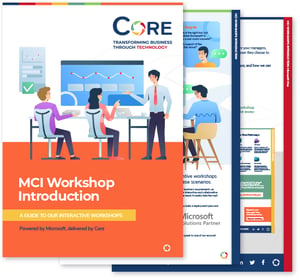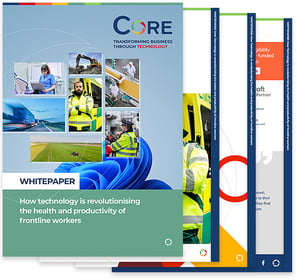Branding and company identity are key buzzwords in the business world; and this blog looks at why it is important to brand your intranet, even though it is for internal use only. So, let’s start at the beginning and look at what branding actually is...
At its simplest, branding is most commonly used to identify one company’s product as distinct from those of another company. The majority of people assume that branding involves a logo, a set of fonts and colours; essentially, that branding is the visual design concept of a company. However, brand and branding are much broader concepts which encompass the company’s image, ethos, industry and its collective values.
One of the many questions when planning an intranet project, is whether or not to brand the site. Why do we need to worry about branding something which is an internal site for employees that no customer is ever going to see? Furthermore, if you are an intranet user and an employee, why do you need to be reminded of who owns and runs the site? Is it not the case that most employees don’t care about consistent branding throughout their intranet? Is it the case that only the higher echelons of the corporation, and those that are paid to do so, care whether or not their intranet reflects the corporate brand?
Throughout this article I hope to unearth some of the benefits of branding your intranet, and also suggest some tips on how to best approach intranet branding. What are the benefits?
Sense of community
Perhaps the most commonly associated benefit of intranet branding is corporate brand consistency. If an intranet reflects the corporate brand effectively, then it not only identifies the intranet as distinct from other sites but it may help to remind the employees they are working for a single organisation rather than a loosely-knit group of individuals. This might seem to be the most obvious benefit, but this works on other levels within an organisation as well. When working in a department, it can often feel like you’re isolated from your colleagues in other departments (having worked in IT for five or so years this is certainly something keenly felt by myself). However, successfully branding your intranet can be a mechanism for helping to create a sense of unity and community within your organisation.
Create a foundation
As an employee of any organisation, it can sometimes feel like we are passengers on a ship directed by forces we can’t control, whether those forces be internal or external, company restructuring, staff attrition or even the company being sold to another organisation. Often, an intranet with a strongly-branded identity can provide a sense of stability and enforce the sense of a solid foundation.
Define objectives
It is possible through the use of clever intranet branding to help define and communicate how the organisation expects employees to use the site. For instance, the use of bright colourful imagery and playful fonts will present a more sociable and less corporate site, in which case the site may be intended for the exchange of more light-hearted content. On the other hand, more subtle colouring and traditional fonts may suggest a more corporate site, perhaps a site in which more sensitive and private documentation is handled. It may even be that different areas or sub-sites of the same intranet have separate subtle brands to indicate the nature of the content that the user can expect in that area and in doing so enhance the use of that area.
Meeting expectations
We are spending an increasing amount of time online. Some studies have shown that one in four people in the UK spend more time online then they do asleep; mostly on social networks and shopping sites. For good or bad, the ever-growing prevalence of the web in our lives means that employees’ expectations for the websites will be set considerably higher by the wealth of sites available.
The majority of intranet products have an ever increasing set of integrated tools to functionally match the users’ expectations. Certainly, SharePoint continues to offer an ever-growing range of powerful tools that should appeal to these users; please take a look at my blog, A Diary from the European SharePoint Conference 2013, which details some of my findings from the conference on SharePoint 2013’s tools.
As well as a set of functional expectations, the experienced online user will be accustomed to web functionality which is communicated to them in a visually engaging and appealing way, often driven through a strong brand identity. The vast majority of high-end websites have a strong brand identity that identifies one company’s product as distinct from that of another company. If this same calibre of branding does not exist within a company’s intranet, the user may feel that they have not been provided with the full online experience and quality which they have come to expect from other websites, and therefore will be less likely to use the site.
Tips on how to brand your intranet
The level of effort involved in branding your intranet can vary massively between companies, but no matter how extensively you wish to brand your sites here are a few tips to start you off...
Who is the owner?
It is important to identify who owns the project of branding your intranet. This can be either a committee or individual, but essentially someone who has been given the power to take the lead on any branding related decisions.
Parent and child brands?
In some companies, branding can be conceptualised as a single brand or one parent brand and several ‘child brands’, which, whilst having their own distinguishing features, also embody the concepts of the parent. These child brands may incorporate a separate logo or different colour sets. The General Dental Council, a client of Core’s, elegantly distinguished their intranet from their website by applying a separate logo and using a range of purple colours rather than the blue and green colours used on their website.
Many companies have a strong brand identity which is projected onto their external presence, but by subtly subverting the mother brand you can give the impression that your intranet offering is something different, and something specially designed with the employee community in mind. However, when departing from the corporate identity in this way, be sure to err on the side of caution; you don’t want your site to be unrecognisable from your company’s brand. The ideal situation is a child-branded intranet site that encapsulates the essence, image and values of the mother brand, but which offers something different.
User feedback
I believe that an intranet should not just be an employee tool but a crucial part of the workplace environment, and that in this capacity the branding should be both a reflection and a reminder that the intranet has been created by the people, for the people. With this in mind, it’s a good idea to listen to your users and obtain their opinions on not only the functionality of the site, but also the branding and user interface design. This can be done via surveys, workshops and user testing.
Do you agree with the points made in this article? How does your organisation brand your corporate intranet? Does branding your intranet help to make it a more participatory, engaging and effective virtual workspace environment?






